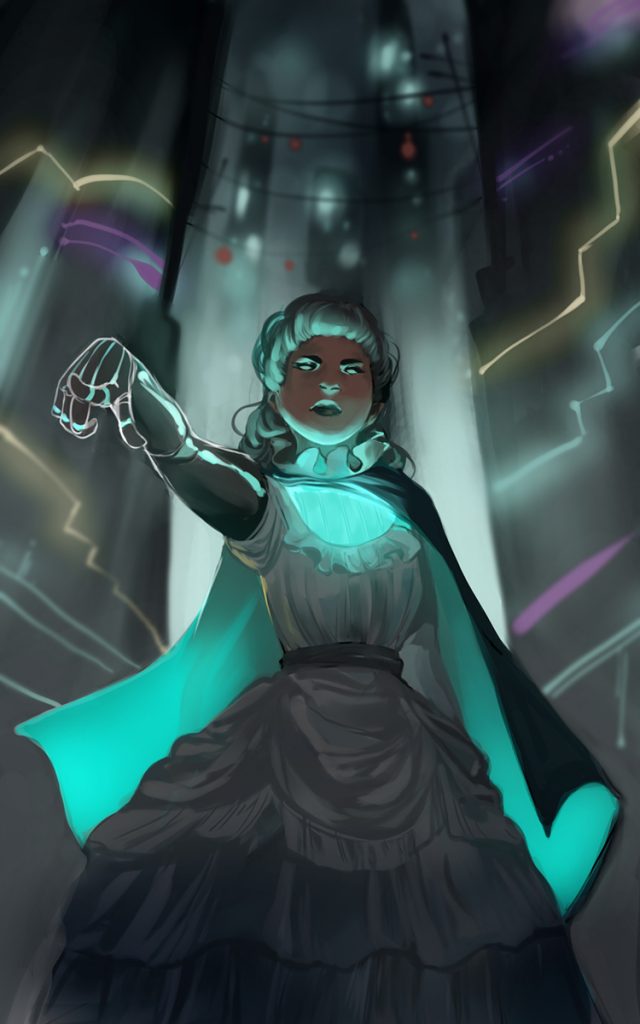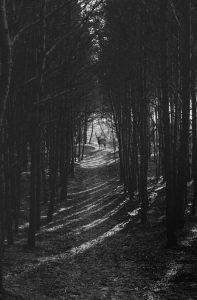 There’s no crown on her head, but from this distance she seems like a queen. Power radiates around her, the city nothing but neon lights in her wake. The dress and cape are old fashioned, prim ruffled collar stretching up to her neck. Her chest glows and the metal of her arm shines in the darkness. Incongruous, yet radiant — you can’t help but follow where she beckons.
There’s no crown on her head, but from this distance she seems like a queen. Power radiates around her, the city nothing but neon lights in her wake. The dress and cape are old fashioned, prim ruffled collar stretching up to her neck. Her chest glows and the metal of her arm shines in the darkness. Incongruous, yet radiant — you can’t help but follow where she beckons.
When we reached out to buboplague for our Retribution Cover Art, we were inspired by historical images of black Victorian women. We asked for a sci-fi inspired setting: bright lights, cityscape, and a metal arm. We wanted a powerful woman facing her audience.
Like the woman in this artwork buboplague works within two realms. She’s known for two seemingly opposing aesthetics. Digital illustrations with high contrast images that look like still dripping ink, and traditional artwork with a variety of brushwork.
This is actually something I wonder about often – had I picked to focus on one, would I have been better off in it than I am now with both?…I started off on paper and it’s always felt more natural to me, but digital is so much more convenient (no mess, less room needed, fun tools), that I started to just flip between the two depending on what was needed.
buboplague’s brush and ink artwork was Inspired by her grandmother, and her family’s own interest in traditional culture. buboplague began to apply Japanese folklore and history and create her own ukiyo artwork. Ukiyo translates to ‘floating world’, and was a term used to describe the pleasure seeking lifestyle of the edo-Japan.
It’s been something I’ve been exposed to since childhood. I’d dabble in sumie and things, but I didn’t start to seriously sit down and go “I’m going to learn this” until a few years ago. I was (and still am) binging a lot of old Japanese folklore, fiction, and history, and thought “heck, why don’t I try it?”
buboplague has been productively working as an artist for over 14 years, attending her first conference in 2005. She’s seen the world of artist conference change from “from flat print binders on empty tables to sprawling upward displays of merchandise”. She’s learned the art of making connections, making friends, and learning new tricks. One of buboplague’s talent is creating small, detailed 1” enamel pins to sell online and at conferences. She first creates the design on paper before transposing it to digital to assess the thickness of the lines. If you’ve ever seen buboplague’s pins, they’re brightly coloured little stories that you want to wear everywhere.
Working with buboplague was a great experience. She was patient as we fumbled our explanations and was excited to work with our original concept. When we were unsure about colour choices, she was willing to step forward and offer opinions.
buboplague is nothing but positive when thinking about her artwork. She’s conquered both traditional and digital art styles. She hustles to conferences, updates her websites with current sketches, and produces gorgeous one-of-a-kind enamel pins.
I have no idea where my artwork is going, and in a way that’s almost fun. I can take it anywhere – back to old dip pen and ink lines, or jump into something new, like environments. There’s always something.
Artist Interview with buboplague
Standard interview question: where are you from, how did you start drawing?
I’m from the US; I’ve always liked drawing since I was little. I have an older sister who would draw sometimes, and it inspired me to pick it up too, except I never really put it back down. Been a hobby all my life!
What has been some of your biggest artistic influences (both visual/non-visual artists, like writers and musicians)?
A lot of friends and acquaintances are big influences on me, and it’s been amazing to grow together and inspire one another. Video game artists (like Yoshitama Amano, Akihiko Yoshida), traditional artwork (Hokusai, Yoshitoshi), music (literally anything), even toys — it all plays into it.
Are there any personal elements (like family history or personal stories) that you try to incorporate into your artwork?
I think most of my artwork is purely visual, or fictional in narrative. Every now and then I may sprinkle some personal feelings in but it’s not something I consciously look to do, although I admire those that can! The ones that have a subtle personal touch tend to be the ones I have stronger preference for, and I may not even realize I put something personal in it until after the fact.
I noticed that you have a background in criminal justice. The legal field is fact-oriented and reaches backward for precedents — has your background impacted your art in anyway? For example, are you more likely to research reference photo or completely work out of a imaginative realm?
Haha, I’m surprised you took note of that! I don’t think it really has a huge impact; it’s just another interest. Identifying patterns, problem solving, and research are important in that field, and I do find myself often “studying” artwork that I enjoy to try and break it down mentally, or researching a lot on my down time – but I think everyone does that to some extent as an artist. Sometimes I have noir themes pop up in my work but that’s about it I suppose!
As for reference vs imagination, I tend to pull from imagination more, but I’m all for learning from reference if needed.
On your website and sketchbook, you balance between digital and traditional art. You seem just as comfortable using Illustrator as you do using ink. Why have you decided to focus on the two aesthetics?
This is actually something I wonder about often – had I picked to focus on one, would I have been better off in it than I am now with both? Am I dividing my skills? At the end of the day, I enjoy both, so it’s not that big a deal.
I started off on paper and it’s always felt more natural to me, but digital is so much more convenient (no mess, less room needed, fun tools), that I started to just flip between the two depending on what was needed. Ultimately, some things are easier to achieve one way vs the other for me. For instance, I love thick, painty work — but I no longer have the space to do it traditionally, so it’s way easier to do it digitally. Getting the natural washes or strokes that are in ink is difficult for me on PC, so it’s easier to just pop out some paper and do it traditionally. Some things just feel better one way or the other; if I’m doing gestures or studies, it almost always has to be on paper, because it feels weird on the computer.
I’d say I’ve focused more on digital the last several years than I have traditional because of convenience.
How did you develop your ukiyo-e artwork. Was the ‘Floating World’ a concept you were always familiar with or did you develop the interest through your work?
My grandmother is from Japan, and both she and my mom had an interest in traditional culture, so it’s been something I’ve been exposed to since childhood. I’d dabble in sumie and things, but I didn’t start to seriously sit down and go “I’m going to learn this” until a few years ago. I was (and still am) binging a lot of old Japanese folklore, fiction, and history, and thought “heck, why don’t I try it?” (see above: always trying new things, haha). Kaiki/kaidan stories are one of my absolute favorite genres, and I think consuming so much in a condensed time frame helped in planting that desire to learn to create in the same aesthetic.
Your floating world illustrations are a collection of Japanese-style artwork. I love the the colour placement, especially on you rely on one or two dominant colours. Do you have any plans for the collection?
Thank you so much! I’d love to do more with youkai and monsters in the future. I’ve toyed with the idea of illustrating a tarot deck around the theme or style, but we’ll see, as that would be a very large project at 78 pieces!
The pins you sell online are incredibly well done and gorgeous with the colours and linework. How have you managed translating an original design into a small pin while still maintaining a high level of detail?
Thank you. It always feels a little tricky! I’m used to working with thin lines, so scaling down hasn’t been too much of an issue if I keep the size in mind while designing, especially since I prefer smaller pins (1”-1.25” ideally). Usually I start out doodling the design on paper at the size it’ll be made at, then redoing it on PC. Something that’s always been helpful is to increase the thickness of the artwork lines and print it at the size it would be made to double check – that helps me to see if the design is workable at such a small size.
For online artists, curating an audience is almost as important as curating an aesthetic — how do you represent your work online? Where do you try to promote your work?
Way back in the old days of interwebs, I only had a Deviantart account, and there wasn’t much idea of curating then, I think. Now it’s like.. Whoa. I’m on Twitter, Instagram, and Tumblr, with Twitter being the easiest place to interact with me and Tumblr being the best archive (thanks, tags!).
I try to post artwork regularly regardless of themes or curation; doodles, scribbles, paintings, Japanese stuff, woodland aesthetic, ghosts, it all gets thrown out there onto the same accounts. There’s a lot of pressure on artists nowadays to have a curated clean gallery, and it’s something I try hard not to get caught up in since I enjoy creating a wide variety (but there’s nothing wrong with those that have found their niche!).
I’m basically at the mercy of those that watch me, so I’m always grateful to them, and always deeply touched when others enjoy what I do.
As an outsider to the artworld, from my perspective conventions are seen as the ‘you made it’ mark for artists, where you can reach a larger audience, make new commissions, and sell current artwork. What’s your experience with the convention circuit and how to you recommend new artists approach the circuit?
Oh gosh, my first convention as a selling artist was 2005. I’ve been in and out of the circuit for long enough to see it evolve from flat print binders on empty tables to sprawling upward displays of merchandise. And even now, I’m still constantly learning and reworking what I do to try and make the best of it. I still have no idea how many of something to make! The best part though are the connections with other artists – seeing my con buddies is the highlight of every show.
My advice to new artists would be: never be afraid to try to apply to places, or be intimidated by people who have been doing it longer. Everyone starts somewhere! But do research so you know what to expect.
There’s always a toxic element to fandoms. How do you navigate your passion and your art around other people’s anger and possessiveness?
I’m not actually active in any fandoms, which helps keep exposure to those toxins down, but I do see it trickle in on my feeds. The only thing to do when that happens is be considerate and compassionate and keep an open mind. Understanding a situation and being able to not let it become personal, which remaining civil and respectful, is important to not letting that toxicity bother you. It’s also important to know when to remove yourself — if a topic becomes too heated, or people get too angry, sometimes it’s best to walk away (or mute it) for your own sanity.
I love that you keep excerpts from your sketchbook online. It really shows how you’re continually playing with your style and how you’re able to switch from a strange-melty wolf to a bright-painterly rowboat. How have you seen your artwork develop over the years and where do you see it going?
My art is very all over the place! There’s so much I want to try that I’m always jumping from one thing to another. Switching it up helps keep it fresh for me, and I anticipate I’ll continue to do that, but it does make tracking progress hard sometimes.
I have no idea where my artwork is going, and in a way that’s almost fun. I can take it anywhere – back to old dip pen and ink lines, or jump into something new, like environments. There’s always something.
Last question! Do you have anything to promote to our readers?
Drink water! Get sleep! Make sure to stretch and relax your shoulders!!
If you like a mish mash of shaman woodlandly ink stuff, Japanese aesthetic stuff, and/or thick painty colorful stuff, I hope I can sate some of that desire over at any of my accounts:
Twitter: twitter.com/buboplague
Tumblr: buboplague.tumblr.com
Instagram: instagram.com/instaplague
Etsy: buboplague.etsy.com






